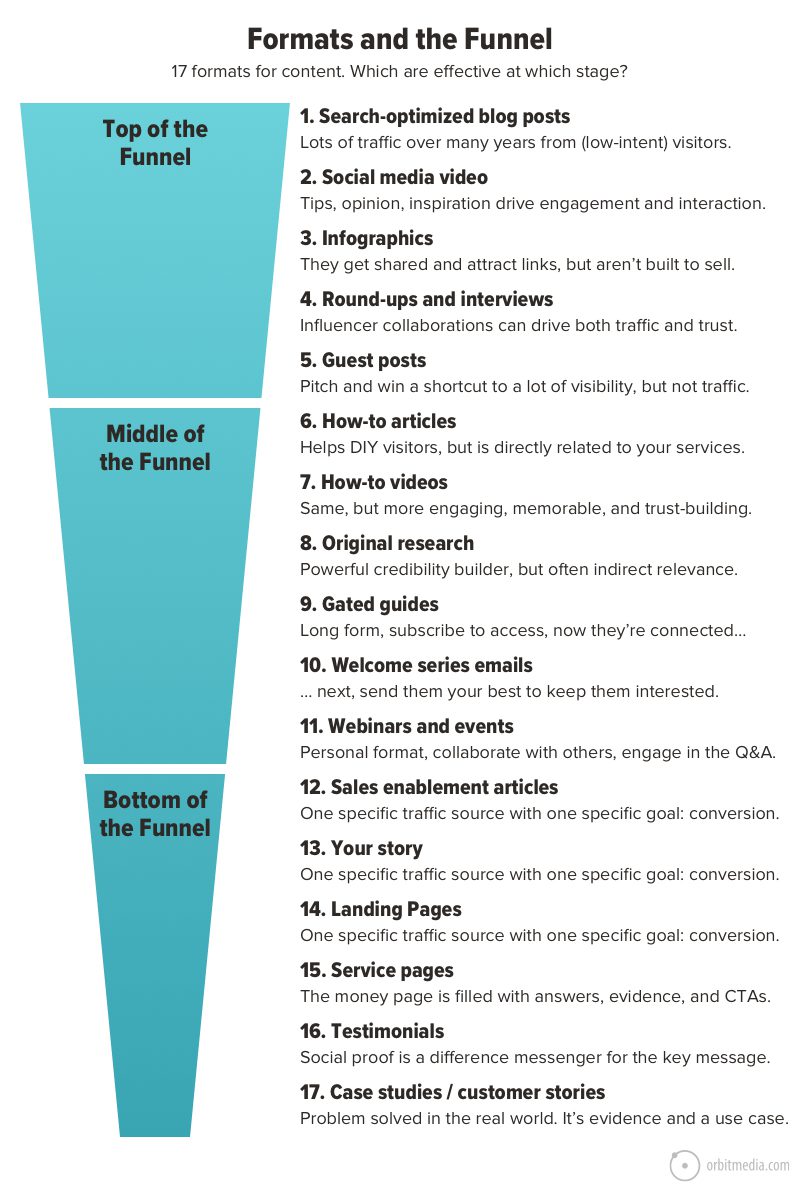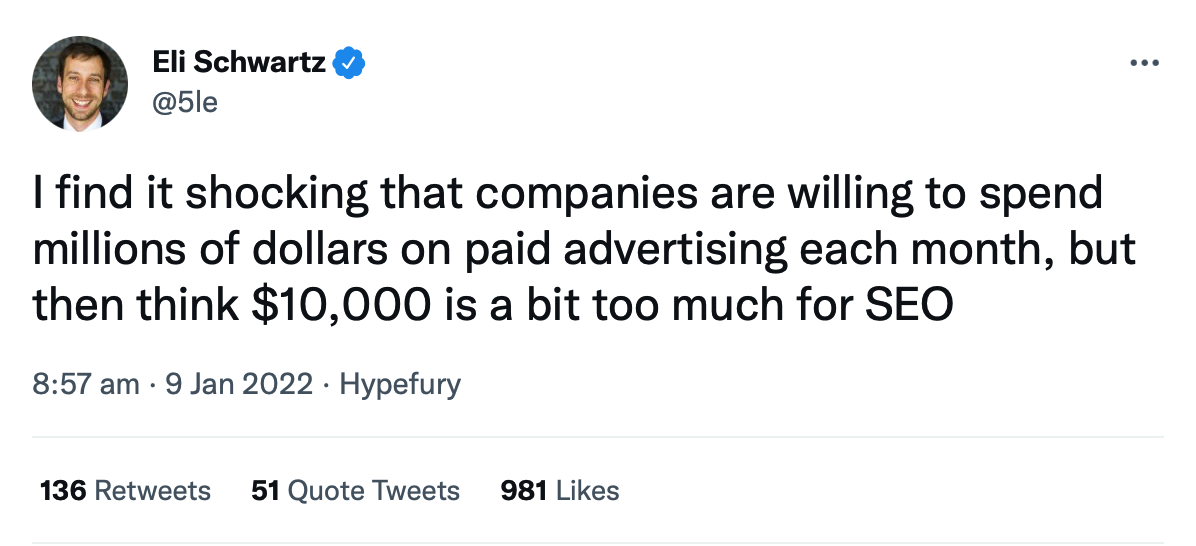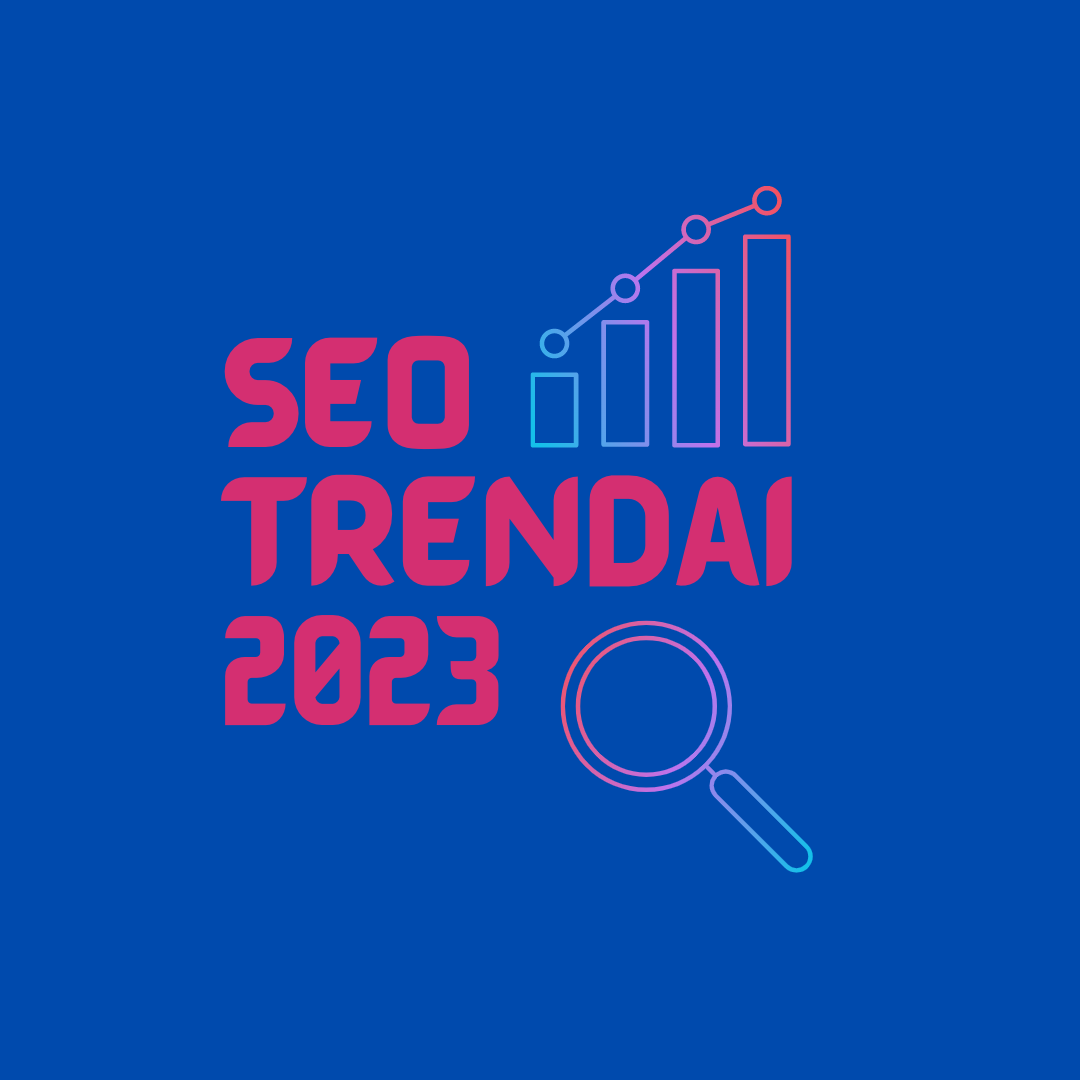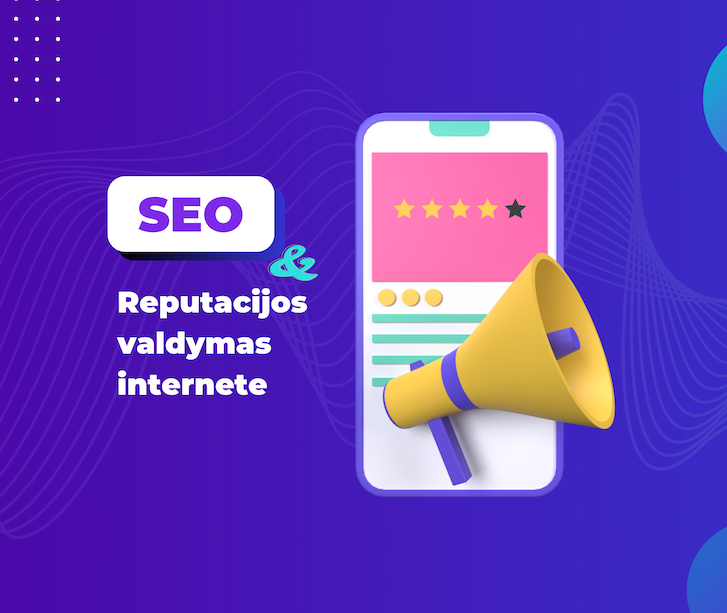SEO (Search Engine Optimization), unlike SEM (Search Engine Marketing), is not a direct growth channel. However, with the right investment, you can achieve great results over time.
Businesses invest continuously. The goal of any investment is to fund something now that will yield a return later.
So why not invest in a traffic acquisition channel such as SEO?
The Holly Miller Anderson Theory:
Investing in SEO is complex. It can be difficult to see the results in terms of traffic and revenue growth because growth is much more visible over time, often up to a year.
Who wants to play a leadership role 12 months from now saying, "Hey, look, we did it!
Unfortunately, that is the nature of organic results. They take time to 'produce'.
This article will look at some of the key factors that drive organic growth and what kind of results can be expected. Specifically, what SEO investments are required in:
- People: building teams to develop and maintain an SEO strategy that drives business results.
- Content: creating and optimizing content based on a solid technical foundation that drives the user experience and the decision to trust and engage with your business over another.
- Tools: SEO and content specialists. Just as a sports team needs a ball and equipment to play, SEO need tools to find the many small optimization opportunities that drive big impact.
Misconception: SEO is "free"
There is no such thing as "free traffic".
Generating consistent, quality web traffic is not free. It never has been.
It doesn't matter if you're a startup, a brand, or any other type or size of business.
The most important thing is to get the best possible return.
This requires investing in the components that contribute to traffic growth.
Another misconception: SEO "just happens"
SEO is about long-term strategy. SEO requires ongoing investment.
The results are obtained over time as the sum of the amount of improvements.
Simply having a website full of content or products to sell will not magically result in organic traffic.
The reality is that any traffic acquisition strategy, especially one related to growing organic traffic, requires investment.
- People are needed to manage the strategy and day-to-day operations.
- Writers are needed to create and optimize content.
- Programmers are needed to code and release improvements to the technical architecture of the website.
Eventually every team in the organization touches the website or app, which means they need to know how to contribute to (and not unwittingly undermine) SEO efforts.
SEO involves multiple teams and works best with continuous improvement.
SEO that delivers real business value requires ongoing, thoughtful investment in people, content and tools.
Organic traffic is a sustainable source of customer acquisition. And SEO becomes your competitive advantage when your website outperforms your competitors.
What is an SEO investment?
At the very least, the resources of SEO teams look like this: people, content and tools.
Companies can choose to invest "everything" in building the team internally or externally, using agencies and consultants, or fund a combination of both.
The only right answer is what works for your business.
Let's take a look at each.
People
In many ways, a business's greatest asset is its people. In SEO, this means using professionals with knowledge of search engines to handle the nuances of maintaining a website (or multiple websites).
This can range from a single subject matter expert to, ideally, an entire SEO team, each with specialised skills or unique expertise (think of any superhero movie where they combine their powers).
Since SEO success depends on the coordinated performance of multiple teams, investment can also involve bringing together people who are copywriters, programmers, strategists, web analysts, data scientists, product managers and user experience professionals.
If the team is not in-house, the investment costs can be allocated to an agency or specialised consultants. The key here is that there is a team of experts who draw on their own resources to create the right SEO strategy for the business. They prioritise the work and collaborate with different teams to improve SEO periodically.
It would be a shame not to mention the acquisition of knowledge. In a dynamic field such as SEO and digital marketing, it is also important for businesses to allocate a budget for the continuous learning and development of their SEO team.
This can be anything that promotes leadership development (e.g. online courses, regional SEO meetings and industry conferences that offer learning and networking opportunities).
Content
Investments in content can take several forms - from hiring an on-site SEO content strategist to oversee a team of writers to outsourcing the work to an agency or consultant.
The bottom line is that no matter how the SEO content team is structured, the key to success is the ability to upload and publish optimized content on the website.
It is not uncommon for a single SEO specialist dedicated to day-to-day SEO operations to also be able to write and publish content on a regular basis (these are known as unicorns).
It is also unrealistic to expect one person to create content for a large business. Such production requires a dedicated team of specialised writers working to an editorial calendar.
Websites cannot be ranked without excellent, relevant content. That is why this type of investment is very important for companies operating on the Internet.
Tools
Physical writers and SEO professionals need tools for content creation, optimization and performance monitoring.
Is there also a cost here? It depends very much on what the business needs and where the gaps are.
It depends on the scope: how many pages will be published and at what pace? What is the size of the team that needs access to the tool (some charge based on the number of access points). There is also a difference in the level of cost of the software tools themselves. From basic keyword and URL ranking tracking up to enterprise level, using more robust data for large sites that need large-scale inspection and analysis capabilities.
There are many options for teams of all sizes and budgets. If you are a marketing manager deciding on tools for your teams and resources, it's best to self-educate and self-assess your business needs.
Paid and earned media (or invest now and later)
Paid search and SEO (earned media) are among the two biggest traffic acquisition investments, which essentially require funding in people, content and tools.
Many believe that investment in both channels should be spread more evenly. In reality, however, the results come at different times.
- Money spent on a paid search campaign produces faster results because campaigns can be managed on a daily, or even hourly, basis, so SEM often receives a larger share of the budget.
- The return on SEO investment is realized over a longer period of time: it can take months or years before a page (or pages) of optimized content is indexed by search engines and starts ranking well enough to attract measurable traffic to the site.
Think of the investment timeframe in terms of a real-life example: you have a garden and want to grow tomato plants. In order to grow that vegetable, you have to go through all of the steps involved in growing that type of plant, which will inevitably take some time.
But if you need tomatoes tomorrow, you will have to buy a fully developed tomato plant and plant it in your garden. This is a paid search.
So if you want tomatoes tomorrow and you haven't looked after your garden properly, they won't be there because gardens don't produce immediate results. That is SEO.
Based on this example, it is clear that it is not sustainable for a business to rely too heavily on paid search to attract customers to its website. The budget will eventually run out or you will be priced out of the market in a price war.
SEO cannot provide immediate instant results in the same way as paid search because it does not work the same way. However, SEO is like a garden that will produce abundant fruit year after year if properly tended season after season.
Investing in an SEO team
In 2021, Google made more than 5,000 changes to search.
That alone is a good enough reason to have an experienced team overseeing every aspect of SEO.
Let's say you're a director or manager and you're tasked with expanding your SEO team. You need to look at your internal resources and what expertise the business lacks.
Perhaps it's an e-commerce site where the business would benefit from a technical SEO specialist with e-commerce experience. Maybe your business needs to double up and update content.
Find whatever SEO skills and experience your business needs.
The bottom line is that every business will need a different combination of SEO skills.
A fully "staffed" in-house SEO team at company level and their expected salary range (USD) looks something like this (United States example, per year):
- SEO Manager: $150,000+
- Senior SEO Manager: $120,000+
- SEO Product Manager: $120,000+
- Technical SEO Specialist: $120,000+
- Content SEO Specialist: $110,000+
- SEO Analyst: (specialising in data science and drawing insights from company data) $150,000+
- Platform Specialist: (corporate websites are built using solutions at scale, such as Salesforce, etc., it is important that you have a specialist who can make technical changes to the website based on the platform it is on) $150,000+.
Remember, you can't just build a team and not equip it with the right tools. A great football team is not only made up of players - you also need a variety of coaches, gear and tools, training facilities and more.
That's why SEO is considered a long-term investment. Hiring talented and experienced individuals to maintain and improve the content and technical architecture of your website is an investment that requires upfront funding and pays for itself later.
It is similar to investing in your own house. The homeowner needs to proactively set aside a budget for home improvement projects and general maintenance of his property. Proper repairs over time mean that when the house is on the market, it is attractive to a buyer and will sell for the best price, which will bring a return to the homeowner.
Just as it is financially sensible to improve a property over time rather than carry out a full renovation, a business needs SEO specialists to maintain and improve the website thoroughly and in its own time.
SEO is profitable: the ROI of SEO
The key performance indicators for SEO are traffic and revenue.
How much traffic can SEO increase? This can be difficult to determine as it depends on many factors, such as:
- How often do you implement improvements to your website?
- What are they?
- Are they relevant and will they have an effect?
One way to make this calculation: take a baseline of your current annual organic traffic (from a traffic source such as Google Analytics). Then ask "what does a 1% increase look like?". And later: "If we do nothing, what would a hypothetical 1% decrease in traffic look like?".
This is your +/- baseline, where you can predict up to 5% in either direction by estimating the increase or decrease in website visits.
For context: "doing nothing" means that there are no technical SEO improvements or updates to existing content, or we do not publish new content.
Important: Doing nothing can sometimes cost more than a small investment in SEO.
Measuring the ROI of SEO
SEO should be seen more broadly as an investment, as it does not deliver immediate results from day one for the money spent.
Think about the reason why it is considered financially viable to invest money in a 401k account, as the funds are expected to grow over time and be larger when needed in the future. This is due to the continuous investment in the fund and the complex growth. The same applies to SEO.
Smart marketers know that search is a traffic channel that expands over time as the website improves.
"Search is an important part of a website's traffic, as can be clearly seen in almost any Google Analytics account you can view," says Krista Seiden, founder and principal consultant at KS Digital. "Whether it's last-click attribution or a multi-touch path to conversion, organic search is a key driver for many businesses, making it an important reason to invest in the channel itself."
Content optimization is another measurable SEO investment that requires upfront funding and pays dividends.
Most marketers should be familiar with the stages of the buyer's journey:
- Awareness
- Consideration
- Decision
Customers are known to search for different types of content based on where they are in their evaluation process. The most important thing is that your content is relevant to the customer's search objective.
This fantastic illustration by Andy Crestodina of Orbit Media highlights the type of content a business should provide to attract, inform and persuade someone to buy its product:

Now think about how many types of content your company has or doesn't have, from each column of that list. When was the last time that content was updated? What content is missing that you should create to make your offer more competitive?
Let's say you conduct a content audit of your website and find that you don't have any educational content. Hypothetically, it might cost $500-$1,000 to have a 1,500-word article written and published on your website so that when people search for things like "how to change an LG water filter", you have an article that can appear at the top of the search page.
If you're lucky, the article is comprehensive on the topic, relates to many of the terms people search for, and maintains its ranking on the first page of Google for months, if not years. The result is that the initial one-off cost of creating an article contributes to many subsequent sales.
In short, investing in content optimization creates value year after year.
SEO investments by business size
Now let's see how this can be profitable at different levels. Please be critical, as these are rough estimates to understand what the distribution of SEO investments might look like in terms of annual revenue and business size.
Startups, small businesses
- Number of employees: 5-50 (full-time)
- Annual revenue: <$50M.
- Rough SEO Investment: $1-$5K/month, $60K/yr.
- Revenue from SEO channel: between 2-5%.
For start-ups and small businesses, investing in SEO is best done once the marketability of the product has been established. Most start-ups need to acquire paying customers quickly. Once customers provide stability and a steady income, SEO can step in and improve the existing content and performance of the website to strengthen the product and attract more prospects.
Most small businesses should invest in SEO, but often don't because it is expensive and there is often no one other than the business owner to update the website. By investing a small amount in SEO services, you will be able to attract traffic to your retail outlets.
Agencies and/or specialist consultants in the local SEO space are great resources as they can often take on the task of making a website mobile-friendly and optimizing content such as Google Maps and Google Business profile entries.
For SMEs, hiring an SEO specialist should be the equivalent of hiring a trusted, licensed professional to sort out their tax accounts. Not every business owner can or should do it themselves. Hire an expert to look at your SEO needs for your business.
A recommendation for small and medium-sized businesses would be to start spending at least $1,000 per month on SEO services. Take it out of your advertising or marketing budget for 3 months and see what you can achieve.
Medium-sized businesses
- Number of employees: 50-250 full time employees
- Annual Revenue: $50M-$1B
- Rough SEO Investment: $10-$20K/month, $240K/yr
- Revenue from SEO channel: between 5-10%
Medium-sized companies should invest in SEO as it is a more cost-effective way to attract customers in the long term and to get the most out of their SEO investments, as companies usually have some resources to support their internal SEO leaders with external agencies or consultants. At this level, investment in SEO can make the difference between being able to increase efficiency on a large scale and outperforming competitors or being left behind.
In medium-sized companies and agencies, the marketing team is usually responsible for maintaining the website. An SEO specialist may be part of this team, but technical and content resources may still be lacking.
A medium-sized company is where SEO can really grow the business. But without a knowledgeable expert to oversee the technical aspects of your website and optimize your content according to what real people related to your business are looking for, you are missing an opportunity.
Enterprises
- Number of employees: 1,000+
- Annual Revenue: 1M+
- Rough SEO Investment: at least $1M/year
- Revenue from SEO channel: between 5-20%
In addition to the consistent performance of several teams, SEO results also depend on investment. Enterprise SEO is more about setting up processes so that different functional teams can improve technical aspects such as architecture, internal linking, and crawling and indexing efficiency.
In the content area, it is about working with internal brand and content teams to write and publish large-scale content optimizations that provide a better user experience than competitors' sites.
Large websites often need more than fixing the problems flagged in an SEO audit. As SEO is essentially a cross-functional discipline, if a company wants to thrive on its organic traffic, it needs strategic oversight to prioritize and collaborate internally across the many different teams doing SEO work; product, engineering, quality assurance, delivery, content, user experience and design teams.
“[To] see SEO results you need more than SEO investment – SEO relies on product, technology and content. It’s a hybrid, complex domain that is interdependent on other resources, teams and outputs.” – Tom Critchlow in his email newsletter SEO MBA
SEO success depends on cross-functional teams, especially engineering and content performance. If you can't publish code or content, don't expect your SEO traffic to improve.
The benefits of SEO
Even a small investment in maintaining your website's performance, content and user experience can add up over time to a business that can generate returns year after year.
SEO is always a great investment because humans are by nature curious: we're always looking for ways to solve our problems, new places to eat, shortcuts to where we're going - we're built to ask questions, and a handy mobile device in our pocket that's connected to the internet 24/7 is ready to answer every query.
Here are some key SEO statistics:
- 93% of the time, an online session starts with a keyword search on a search engine.
- In 2023, 53.3% of all website traffic (worldwide) will click on organic results.
- Google alone processes more than 40,000 keyword searches every second. That's more than 3.5 billion searches in a single day and 1.2 trillion a year!
- 16-20% of keywords searched on Google on any given day have never been searched before.
These compelling statistics show that search isn't going anywhere soon.
In addition to curious people, another benefit of investing in SEO is that it addresses many of the same problems associated with the need to make websites easier to navigate for a percentage of disabled people. This practice is known as accessibility.
It's not a 1:1 correspondence, but there are many technical SEO principles that also mean that those who have to navigate websites using a screen reader (data shows that 8.1 million Americans are visually impaired) have a better user experience.
In addition, SEO with disability labels used in QA automation makes things even more efficient, as these labels make testing automation easier. This is a great achievement for several internal teams contributing to SEO and increasing business value.
SEO tactics worth investing in
Page speed
In 2022, North Starof investments are improving website speed and performance according to Google's measurements known as Core Web Vitals (CWV). These are the aspects that help a website load quickly for both search engines and users.
Many teams organize around:
- LCP (Largest Contentful Pain): loading the main content first to make everything else look smooth.
- CLS (Cumulative Layout Shift): reduces the number of elements that "jump" or move around on the screen while it loads.
- FID (First Input Delay): the time it takes for users to interact with the page for the first time so that they can do what they were meant to do.
In principle, your website pages should load quickly. Speed became a ranking factor in July 2018 and users expect it. However, speed alone will not increase traffic.
Relevant and authoritative content
Improving your content (updating existing content or cutting back on poorly trafficked pages) is one of the best investments in SEO.
Why?
"Google is getting better at determining user intent. This means it's important to monitor your content and ensure it's useful, accurate and relevant.
It's worth investing in updating your content to improve your E-A-T signals:
- Expertise
- Authoritativeness
- Trustworthiness
General searches at the top of the funnel are usually where SEO is most effective for a company's business. Big brands can usually afford a bigger budget for paid search, but over time, a business benefits greatly from bringing new visitors to a website through strategic, ongoing investment in well-written, relevant content.
Technical SEO results
This refers to the speed or rapidity with which engineering and product teams can collaborate with teams of SEO specialists to resolve technical aspects of a website. A consistent level of performance will contribute to a healthy and solid technical foundation.
Generally speaking, if a website has been up and running for 6 months or more and there are no technical improvements, it may lose significant rankings and therefore traffic. The site may not be as competitive online as that of others, where teams are looking to test and learn to improve the SEO results that they see.
Some reasons not to invest in SEO
Suppose you are:
- A start-up that hasn't found the right product for the market.
- You are a reseller of other brands' products who is just trying to generate revenue. Continue to reach out to influencers...
- You are under the illusion that link building is the only way. Have fun with that.
- You have to meet user number targets for investors, which means you should be looking at paid search to attract customers quickly, then use SEO to retain them.
- If your company has limited or no engineering resources. SEO depends on partnerships with and frequent output from programming and content teams.
- When you can't afford to pay a knowledgeable consultant or agency for their services. Worldwide, SEO providers charge an average of USD 112.22 per hour and 50% of SEO providers worldwide have a minimum monthly fee of up to USD 3 000 per month.
SEO requires investment and collaboration to work
Make no mistake: SEO is two things. It's both work and value!
Have you ever heard the saying: "Everything worth having is hard or requires work?". The same goes for SEO.
It loads quickly, is safe to process, and its content is relevant and useful - it's the foundation that needs to be maintained for a website to be competitive online.
The notion that organic traffic "just happens" and costs nothing is completely wrong. It takes investment to turn organic traffic into a meaningful marketing channel and generate sustainable returns.
Continuous organic traffic is one of the strongest foundations of a business.
Investing in SEO is worthwhile because everyone on the planet is looking for products, services and information to make their lives easier. Your business needs to be at the top of your customers' consideration list.
For businesses, investing in SEO is essential because it is uniquely designed to optimize the technical aspects of a website for search engines, so that real, online searchers can find it in search of great products and solutions.
Remember that the return on investment of SEO is not immediate: it accumulates over time. Paid search is either on or off. What happens when your paid ad budget runs out?
SEO is a channel that will always work. You just have to keep investing.
Original text by Holly Miller Anderson on Searchengineland: Why SEO is a great investment, not just a cost




